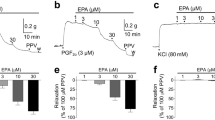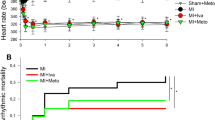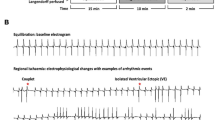Abstract
There has been much interest in the possible physiological and pathophysiological roles of myocardial prostaglandins1. One particularly intriguing suggestion2 is that they may be capable of protecting the heart against arrhythmogenic stimuli. There is certainly no doubt that some prostaglandins can protect against a variety of arrhythmias induced either chemically or by coronary artery ligation2–4. For example, PGE2 and prostacyclin are effective against the early post-infarction arrhythmias that result from acute coronary artery ligation in anaesthetized dogs3 and rats4. In a previous study5,6 we could find no evidence that PGE2 (or PGF2α) was released from the canine myocardium at a time when ventricular ectopic activity was pronounced. We now demonstrate that, in contrast, both thromboxane and prostacyclin are released from the acutely ischaemic myocardium and that the balance between thromboxane and prostacyclin release in the period immediately following coronary artery ligation is related to the occurrence of arrhythmias.
This is a preview of subscription content, access via your institution
Access options
Subscribe to this journal
Receive 51 print issues and online access
$199.00 per year
only $3.90 per issue
Buy this article
- Purchase on Springer Link
- Instant access to full article PDF
Prices may be subject to local taxes which are calculated during checkout
Similar content being viewed by others
References
Sivakoff, M., Pure, E., Hseuh, W. & Needleman, P. Fedn Proc. 38, 78–82 (1979).
Förster, W. Acta biol. med. germ. 35, 1101–1112 (1976).
Harvie, C.J., Collins, G. A., Miyagishima, R. T. & Walker, M. J. A. Prostaglandins 16, 885–900 (1978).
Au, T. L. S., Collins, G. A., Harvie, C. J. & Walker, M. J. A. Prostaglandins 18, 707–720 (1979).
Coker, S. J., Marshall, R. J., Parratt, J. R., Siddiqui, H. H. & Zeitlin, I. J. J. molec. cell. Cardiol. 11, Suppl 11, 8 (1979).
Coker, S. J., Marshall, R. J., Parratt, J. R. & Zeitlin, I. J. J. molec. cell. Cardiol. (in the press).
Marshall, R. J., Parratt, J. R. & Ledingham, I. McA. Cardiovascular Res. 8, 204–215 (1974).
Coker, S. J. thesis, Univ. Strathclyde (1980).
Dray, F., Charbonnel, B. & Maclouf, J. Eur. J. clin. Invest. 5, 311–318 (1975).
Terashita, Z-I., Fukui, H., Nishikawa, K., Hirata, M. & Kikuchi, S. Eur. J. Pharmac. 53, 49–56 (1978).
Author information
Authors and Affiliations
Rights and permissions
About this article
Cite this article
Coker, S., Parratt, J., Ledingham, I. et al. Thromboxane and prostacyclin release from ischaemic myocardium in relation to arrhythmias. Nature 291, 323–324 (1981). https://doi.org/10.1038/291323a0
Received:
Accepted:
Issue Date:
DOI: https://doi.org/10.1038/291323a0
This article is cited by
-
Metabolism pathways of arachidonic acids: mechanisms and potential therapeutic targets
Signal Transduction and Targeted Therapy (2021)
-
Cardiac thromboxane A2 receptor activation does not directly induce cardiomyocyte hypertrophy but does cause cell death that is prevented with gentamicin and 2-APB
BMC Pharmacology and Toxicology (2014)
-
Electromechanical characterization of cinnamophilin, a natural thromboxane A2 receptor antagonist with anti‐arrhythmic activity, in guinea‐pig heart
British Journal of Pharmacology (2008)
-
NCX4016 (NO‐aspirin) reduces infarct size and suppresses arrhythmias following myocardial ischaemia/reperfusion in pigs
British Journal of Pharmacology (2002)
-
Combined administration of 5‐HT2 and thromboxane A2 antagonists: effects on platelet aggregation and isolated cardiac muscle
British Journal of Pharmacology (1997)
Comments
By submitting a comment you agree to abide by our Terms and Community Guidelines. If you find something abusive or that does not comply with our terms or guidelines please flag it as inappropriate.



